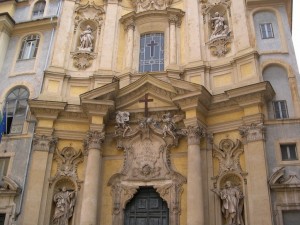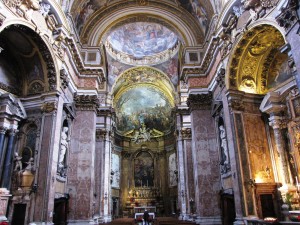Amici states that un accordance with the will of God, in Rome ‘the cult and veneration of St. Mary Magdalene was promoted with greater alacrity and splendour and to this end the humble church dedicated to her was entrusted to a religious Order which not only had to reignite in the hearts of the faithful love and devotion for this saint but also with the passing of time had to take on the praiseworthy task of transforming that church itself into a sumptuous temple which that most famous saint deserved in the Eternal City’. He also observed that the ‘glorious destiny of the converted and penitent servant was one day shared and inseparably linked to that of the great convert and penitent of the Gospel, given that both of them greatly loved that Cross which they chose as their distinctive emblem, both together in the same temple to generate in all the faithful a perennial worship of honour, veneration and glory’.
Indeed the same biographer – Ciccatelli – narrates that St. Camillus, after reflecting upon a number of churches in Rome, when he entered, in the eve of the feast day of St. Mary Magdalene, the church of the same name, found that it met the needs of his Institute and, commending himself to the Lord as well as to the saint herself, decided to make a request to obtain it.
He succeeded completely and achieved his goal with the help of authoritative people, amongst whom, in a special way, mention must be made of the Roman Noblewoman, Princess Felice Colonna.
The necessary negotiations on the matter were completed and thus on 22 December 1582 the signing of the contract took place.
As soon as he had obtained the above-mentioned church, Camillus hastened to take regular possession of it, beginning by running it in the best way he could at the outset, after establishing his community which at that time according to Ciccatelli was made up of ‘not more than 12 religious, in some small rooms of the same church’.
In the meantime, however, giving the importance of the commitments that had been made by the Archconfraternity of Gonfalon and by our Congregation, and this was an ecclesiastical question, the two contracting parties, to achieve greater defence and guarantees for the contract, decided to submit it for the approval and confirmation of the Apostolic See. And this took place with Pope Sistus V who, through his special Bull of 20 March 1587 (which is kept in the general archives: AGMI, 2313), was pleased to accord fill confirmation and ratification to this contract.
In his account, Amici reproduces a number of clauses of this contract: ‘The Ven. Archconfraternity of Gonfalon grants to Fr. Camillus de Lellis and his Congregation the use of the church of St. Mary Magdalene which is located in Piazza della Rotonda, with its three bells, that is to say two large ones placed above the roof and a small one at the major altar of this church, excluding other real property and rights of any kind which may belong to it or be possessed by it’.
‘On the other hand, however, the previously praised Fr. Camillus and his Congregation pro tempore in correspondence with, and in recognition of, this concession will be required and obliged to:
- Celebrate or have celebrated in the aforementioned church a Mass every Sunday and official feast days during the year.
- Meet all the expenses for the maintenance of this church as regards things needed for divine worship: lights, oil, wax, screens, ornaments and suchlike, as well as to keep the altars provided with their necessary objects.
 Restore, indemnify and conserve this church with its bells, as well as the paving in front of it, equally paying any tax or contribution relating to it, without in any case charging the Confraternity itself which, indeed, intends that the Church of St. Mary Magdalene, with all the restorations, improvements and building work which may be carried out, including where excessive and not necessary, by the aforementioned Fr. Camillus and his religious, should be returned with no charge to the Ven. Archconfraternity as soon as they leave or their Congregation is dissolved.
Restore, indemnify and conserve this church with its bells, as well as the paving in front of it, equally paying any tax or contribution relating to it, without in any case charging the Confraternity itself which, indeed, intends that the Church of St. Mary Magdalene, with all the restorations, improvements and building work which may be carried out, including where excessive and not necessary, by the aforementioned Fr. Camillus and his religious, should be returned with no charge to the Ven. Archconfraternity as soon as they leave or their Congregation is dissolved.- Organise the church in the usual way on the feast day of the Titular Saint and on that occasion, given that the officials and the other members of the Archfraternity will have to take part in the holy services, they will have the right to an honorific presence and will have a separate and reserved place at the major altar.
- Keep displayed above the outer door the coats of arms of the ruling Pope, of the Cardinal Protector and of the Archfraternity. Moreover, to protect the right to, and ownership of, the church itself, the custodians will be obliged to place on the façade a stone with its coat of arms and an inscription that refers to the absolute dominion and possession of this Archfraternity.
- Lastly, every year on the Feast Day of Saint Mary Magdalene, to make to the Ven. Archfraternity an offering of Wax of five pounds’ weight, and every give years an offering of a Chalice and patena of silver of the value of ten scudos, as a gift of tribute and gratitude towards the Archfraternity.
Source: Amici M., Memorie storiche intorno a S. Camillo de Lellis nell’occasione del 3. centenario della morte del santo, 1614-1914, Tip. Pontificia dell’Istituto Pio IX, Rome, 1913, 99-104pp.
















Camillians on Facebook
Camillians on Twitter
Camillians on Instagram